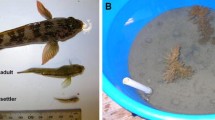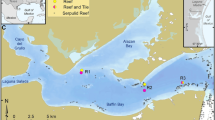Abstract
Recruitment of a group of co-occurring sessile invertebrates (a serpulid polychaete, an oyster, a bryozoan, and several colonial and one solitary ascidian) that encrust floating docks in Pearl Harbor, Hawaii, was studied in August 1985. Daily photographs were taken of acrylic settling plates over a 14 d period, and daily settlement and juvenile mortality were measured. Settlement rates were compared between species and days, while juvenile mortalities were compared between species, days, juvenile ages and densities of juveniles on the plates. Species differed in abundance of both settlers and juveniles, and in rate and pattern of juvenile mortality. Settlement intensity varied between days for some species. Significant juvenile mortality occurred during the 14 d for most species; it appeared to be caused by fish predation. For two species, mortality varied with juvenile age, with older individuals suffering higher mortality. Mortality was density-dependent for some species, increasing with numbers of juveniles on the plates. Mortality patterns varied even within the colonial species. Assessing larval settlement and juvenile mortality for a single species or type of organism in a community thus may not indicate that similar patterns exist for co-occurring species.
Similar content being viewed by others
Literature cited
Buss, L. W. (1979). Habitat selection, directional growth and spatial refuges: why colonial animals have more hiding places. In: Larwood, G., Rosen, B. R. (eds.) Biology and systematics of colonial organisms. Academic Press, London, p. 459–497
Caffey, H. M. (1985). Spatial and temporal variation in settlement and recruitment of intertidal barnacles. Ecol. Monogr. 55: 313–332
Clark, P. J., Evans, F. C. (1954). Distance to nearest neighbor as a measure of spatial relationships in populations. Ecology 35: 445–453
Connell, J. H. (1985). The consequences of variation in initial settlement versus post-settlement mortality in rocky intertidal communities. J. exp. mar. Biol. Ecol. 93: 11–45
Crisp, D. J., Ryland, J. S. (1960). The influence of filming and of surface texture on the settlement of marine organisms. Nature, Lond. 185: p. 119
Davis, A. R. (1987). Variation in recruitment of the subtidal colonial ascidianPodoclavella cylindrica (Quoy & Gaimard): the role of substratum choice and early survival. J. exp. mar. Biol. Ecol. 106: 57–71
Davis, A. R. (1988a). Effects of variation in initial settlement on distribution and abundance ofPodoclavella moluccensis Sluiter. J. exp. mar. Biol. Ecol. 117: 157–167
Davis, A. R. (1988b). Colony regeneration following damage and size-dependent mortality in the Australian ascidianPodoclavella moluccensis Sluiter. J. exp. mar. Biol. Ecol. 123: 269–285
Davis, A. R. (1989). Temperature correlates with the daily release of larvae and their settlement in a temperate Australian ascidian. Proc. 23rd Eur. mar. Biol. Symp. 61–66. [Ryland, J. S., Tyler, P. (eds.) Olsen & Olsen, Fredensborg, Denmark]
Day, R. W., Quinn, G. P. (1989). Comparisons of treatments after an analysis of variance in ecology. Ecol. Monogr. 59: 433–463
Duyl, F. C. van, Bak, R. P. M., Sybesma, J. (1981). The ecology of the tropical compound ascidianTrididemnum solidum. I. Reproductive strategy and larval behavior. Mar. Ecol. Prog. Ser. 6: 35–42
Edmondson, C. H. (1944). Incidence of fouling in Pearl Harbor. Occ. Pap. Bernice P. Bishop Mus. 17: 1–34
Freund, R. J., Littell, R. C., Spector, P. C. (1986). SAS system for linear models. SAS Institute, Inc., Cary, North Carolina
Gaines, S., Brown, S., Roughgarden, J. (1985). Spatial variation in larval concentrations as a cause of spatial variation in settlement for the barnacle,Balanus glandula. Oecologia 67: 267–272
Gaines, S., Roughgarden, J. (1985). Larval settlement rate: a leading determinant of structure in an ecological community of the marine intertidal zone. Proc. natn. Acad. Sci. U.S.A. 82: 3707–3711
Grosberg, R. K. (1981). Competitive ability influences habitat choice in marine invertebrates. Nature, Lond. 290: 700–702
Grosberg, R. K. (1982). Intertidal zonation of barnacles: the influence of planktonic zonation of larvae on vertical distribution of adults. Ecology 63: 894–899
Hurlbut, C. J. (1990). Variations in larval density and settlement in space and time: important determinants of recruitment in sessile marine invertebrates? Ph.D. dissertation. University of Hawaii, Honolulu
Jackson, J. B. C. (1977). Competition on marine hard substrata: the adaptive significance of solitary and colonial strategies. Am. Nat. 111: 743–767
Jackson, J. B. C. (1985). Distribution and ecology of clonal and aclonal benthic invertebrates. In: Jackson, J. B. C., Buss, L. W., Cook, R. E. (eds.) Population biology and evolution of clonal organisms. Yale University Press, New Haven, p. 297–356
Keough, M. J. (1986). The distribution of a bryozoan on seagrass blades: settlement, growth and mortality. Ecology 67: 846–857
Keough, M. J. (1989). Benthic populations: is recruitment limiting or just fashionable? Proc. 6th int. coral Reef Symp. 1: 141–148 [Choat, J. H. et al. (eds.) Sixth International Coral Reef Symposium, Executive Committee, Townsville]
Keough, M. J., Chernoff, H. (1987). Dispersal and population variation in the bryozoanBugula neritina. Ecology 68: 199–210
Keough, M. J., Downes, B. J. (1982). Recruitment of marine invertebrates: the role of active larval choices and early mortality. Oecologia 54: 348–352
Mihm, J. W., Banta, W. C. Loeb, G. I. (1981). Effects of adsorbed organic and primary fouling films on bryozoan settlement. J. exp. mar. Biol. Ecol. 54: 167–179
Olson, R. R. (1983). Ascidian-Prochloron symbiosis: the role of larval photoadaptation in midday larval release and settlement. Biol. Bull. mar. biol. Lab., Woods Hole 165: 221–240
Sokal, R. R., Rohlf, F. J. (1981). Biometry. The principles and practice of statistics in biological research. 2nd ed. W. H. Freeman & Co., San Francisco
Sutherland, J. P., Karlson, R. H. (1977). Development and stability of the fouling community at Beaufort, North Carolina. Ecol. Monogr. 47: 425–446
Underwood, A. J., Denley, E. J. (1984). Paradigms, explanations, and generalizations in models for the structure of intertidal communities on rocky shores. In: Strong, D., Simberloff, D., Abele, L. G., Thistle, A. B. (eds.) Ecological communities: conceptual issues and the evidence. Princeton University Press, New Jersey, p. 151–180
Wethey, D. S. (1984). Spatial pattern in barnacle settlement: day to day changes during the settlement season. J. mar. biol. Ass. U.K. 64: 687–698
Yoshioka, P. M. (1982). Role of planktonic and benthic factors in the population dynamics of the bryozoanMembranipora membranacea. Ecology 63: 457–468
Young, C. M., Chia, F.-S. (1981). Laboratory evidence for the delay of larval settlement in response to a dominant competitor. Int. J. Invert. Reprod. (Amsterdam) 3: 221–226
ZoBell, C. E., Allen, E. C. (1935). The significance of marine bacteria in the fouling of submerged surfaces. J. Bact. 29: 239–251
Author information
Authors and Affiliations
Additional information
Communicated by J.M. Lawrence, Tampa
Rights and permissions
About this article
Cite this article
Hurlbut, C.J. Community recruitment: Settlement and juvenile survival of seven co-occurring species of sessile marine invertebrates. Mar. Biol. 109, 507–515 (1991). https://doi.org/10.1007/BF01313517
Accepted:
Issue Date:
DOI: https://doi.org/10.1007/BF01313517




